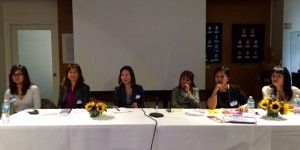Alarm raised on high diabetes rates among Filipinos in US

First National Filipino Health Symposium speakers from left to right: Aimee Afable, PhD; Dr. Charito P. Sico, Kaiser Permanente; Joanna Snyder, RD; Julieta Gabiola, MD Stanford University
SAN FRANCISCO — Seven out of 10 Filipino Americans living in California today are overweight or obese

A 2012 Northern California study of over one million adults observed a diabetes
These are just some of the health findings unveiled at the 1st Annual National Filipino Health Equity Symposium on chronic diseases that was held at the Philippine Center here April 25.
Diet-related chronic conditions such as obesity


New York and San Francisco-based clinical practitioners and experts met with Consulate officials and community leaders to begin a national dialogue on the chronic illnesses facing Filipinos and to help curb these maladies.
Article continues after this advertisementThe symposium was organized by the National Federation of Filipino American Associations (NaFFAA) with the Philippine Consul General of San Francisco Henry Bensuito Jr., represented by Deputy Consul Jaime Ramon Ascalon.
Article continues after this advertisementRaising awareness
An estimated 3.4 million Filipinos live in the US, the second largest Asian ethnic group in America. But little has been accomplished in addressing their public health needs, said experts at the symposium.
“Our goal is to raise awareness of the chronic disease burden of the Fil-Am community,” said Aimee Afable, PhD, MPH, State University of New York (SUNY) Downstate School of Public Health.
Among the steps recommended are to disseminate scientific evidence on the rise of chronic disease among Filipinos and promote the exchange of resources for effective strategies of prevention and management of lifestyle-related chronic diseases.
Rudy Asercion NaFFAA Pacific Region chair, said his group focuses on the youth to help reverse the trends. “We need to start the conversation regarding lifestyle changes, or our kids will have a shorter life span than us.”
Meanwhile, San Francisco City Supervisor Scott Wiener stressed that more young people from the San Francisco Unified School District have Type 2 Diabetes
Asercion said NaFFAA will continue
Alarming obesity
Obesity


Living in the US may influence risk for obesity



Afable said, “We need to balance
This was echoed by Charito Sico, MD, medical director of the Center of Excellence in Culturally Competent Care for Filipino Health for Kaiser Permanente, who said, “The latest findings show one in five Americans that have diabetes
Sico reported that Kaiser has a seven-part program (translated in Tagalog) on Filipino health: Community Health and marketing; Heart Healthy Recipes; Health Education Classes; Capturing Race and Ethnicity data in KP Health Connect; Initiating end-of-life conversations; and Face-to-Face Training.
The hospital, for example, held a two-hour class for Filipino Americans in Daly City and South San Francisco (South City) to modify the traditional Filipino diet and teach how to control diabetes
Barriers to care
There are several barriers to diabetes
Some Filipinos may be working too hard to send money home, or there may not be Tagalog translators available. And a “westernized individualistic approach doesn’t work. We have to include the family where decisions in health care are made as a family,” she said.
Julieta Gabiola, MD, FACP clinical associate professor of medicine educators at Stanford University, noted that while it seems difficult for some Filipinos to stop smoking, control obesity and take up exercise, these are the best ways to prevent hypertension and diabetes.
“Eating is important, but cut back on fat and salt,” she said. “In the Philippines, they pack it up with noodles and rice and not much meat–the food for three meals a day is boiled rice.”
The American Heart Association and the American Diabetes Association
Group approach
Another speaker, Rhodora Ursua, MPH, Asian Pacific partners for Empowerment, Advocacy and Leadership (APPEAL), said her group’s culturally tailored outreach to Filipinos encourages a social approach to preventing diabetes
A representative from Roche Diagnostics Corp. Diabtes Care, Anne Stokman, RN, MSN

Lydee Hershey, RN and president-elect of the Philippine Nurses
Like us on Facebook